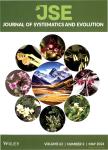Allopatric divergence and regional range expansion of Juniperus sabina in China
Allopatric divergence and regional range expansion of Juniperus sabina in China作者机构:DivisionofMolecularEcologyKeyLaboratoryofAridandGrasslandEcologySchoolofLifeSciencesLanzhouUniversityLanzhou730000China BiotaNorthwestInstituteofPlateauBiologyChineseAcademyofSciencesXining810000China
出 版 物:《Journal of Systematics and Evolution》 (植物分类学报(英文版))
年 卷 期:2010年第48卷第3期
页 面:153-160页
核心收录:
学科分类:0710[理学-生物学] 0830[工学-环境科学与工程(可授工学、理学、农学学位)] 0907[农学-林学] 08[工学] 0829[工学-林业工程] 09[农学] 0901[农学-作物学] 0902[农学-园艺学] 0713[理学-生态学]
基 金:supported by grants from the National Natural Science Foundation of China(Grant Nos.30725004 30560460)
主 题:cpDNA genetic diversity Juniperus sabina phylogeography range expansion.
摘 要:In this study,we aimed to study the phylogeographic pattern of Juniperus sabina,a shrub species commonly occurring in the northern,northwestern and western China. We sequenced three chloroplast DNA fragments (trnL-trnF,trnS-trnG,and trnD-trnT) for 137 individuals from 16 populations of this species. Five chloroplast DNA chlorotypes (A,B,C,D,and E) were identified and they showed no overlapping distribution. The population subdivision is very high (GST=0.926,NST=0.980),suggesting a distinct phylogeographic structure (NSTGST,P0.05). Phylogenetic analyses of the five chlorotypes were clustered into three clades,consistent with their respective distributions in three separate regions:northern Xinjiang,western Xinjiang,and northern-northwestern China. However,within each region,the interpopulation differentiation is extremely low. These results as well as statistical tests suggested distinct allopatric differentiations between regional populations and independent glacial refugia for postglacial recolonization. The deserts that developed during the late Quaternary might have acted as effective barriers to promote genetic differentiation among these regions. However,the low diversity dominated by the single chlorotype within each fragmented region suggested that all current populations were derived from a common regional range expansion.



